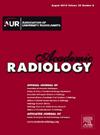Enhanced Image Quality and Comparable Diagnostic Performance of Prostate Fast Bi-MRI with Deep Learning Reconstruction
IF 3.9
2区 医学
Q1 RADIOLOGY, NUCLEAR MEDICINE & MEDICAL IMAGING
引用次数: 0
Abstract
Rational and Objectives
To evaluate image quality and diagnostic performance of prostate biparametric MRI (bi-MRI) with deep learning reconstruction (DLR).
Materials and Methods
This prospective study included 61 adult male urological patients undergoing prostate MRI with standard-of-care (SOC) and fast protocols. Sequences included T2-weighted imaging (T2WI), diffusion-weighted imaging (DWI), and apparent diffusion coefficient (ADC) maps. DLR images were generated from FAST datasets. Three groups (SOC, FAST, DLR) were compared using: (1) five-point Likert scale, (2) signal-to-noise ratio (SNR), contrast-to-noise ratio (CNR), (3) lesion slope profiles, (4) dorsal capsule edge rise distance (ERD). PI-RADS scores were assigned to dominant lesions. ADC values were measured in histopathologically confirmed cases. Diagnostic performance was analyzed via receiver operating characteristic (ROC) curves (accuracy/sensitivity/specificity). Statistical tests included Friedman test, one-way ANOVA with post hoc analyses, and DeLong test for ROC comparisons (P<0.05).
Results
FAST scanning protocols reduced acquisition time by nearly half compared to the SOC scanning protocol. When compared to T2WIFAST, DLR significantly improved SNR, CNR, slope profile, and ERD (P < 0.05). Similarly, DLR significantly enhanced SNR, CNR, and image sharpness when compared to DWIFAST (P < 0.05). No significant differences were observed in PI-RADS scores and ADC values between groups (P > 0.05). The areas under the ROC curves, sensitivity, and specificity of ADC values for distinguishing benign and malignant lesions remained consistent (P > 0.05).
Conclusion
DLR enhances image quality in fast prostate bi-MRI while preserving PI-RADS classification accuracy and ADC diagnostic performance.
基于深度学习重建的前列腺快速双核磁共振成像增强图像质量和可比诊断性能。
目的:评价前列腺双参数MRI (bi-MRI)深度学习重建(DLR)的图像质量和诊断性能。材料和方法:本前瞻性研究包括61名接受标准护理(SOC)和快速方案前列腺MRI检查的成年男性泌尿科患者。序列包括t2加权成像(T2WI)、扩散加权成像(DWI)和表观扩散系数(ADC)图。DLR图像由FAST数据集生成。采用(1)五点Likert量表,(2)信噪比(SNR),对比噪声比(CNR),(3)病变斜率曲线,(4)背囊边缘上升距离(ERD)对三组(SOC, FAST, DLR)进行比较。对优势病变进行PI-RADS评分。在组织病理学证实的病例中测量ADC值。通过受试者工作特征(ROC)曲线(准确性/敏感性/特异性)分析诊断效果。统计测试包括Friedman检验、事后分析的单因素方差分析和DeLong ROC比较检验(结果:FAST扫描方案比SOC扫描方案减少了近一半的采集时间)。与T2WIFAST相比,DLR显著改善了SNR、CNR、斜率剖面和ERD (P < 0.05)。与diwifast相比,DLR显著提高了信噪比、信噪比和图像清晰度(P < 0.05)。各组PI-RADS评分及ADC值差异无统计学意义(P < 0.05)。ADC值区分良恶性病变的ROC曲线下面积、敏感性和特异性保持一致(P < 0.05)。结论:DLR在保持PI-RADS分类准确性和ADC诊断性能的同时,提高了快速前列腺双磁共振成像的图像质量。
本文章由计算机程序翻译,如有差异,请以英文原文为准。
求助全文
约1分钟内获得全文
求助全文
来源期刊

Academic Radiology
医学-核医学
CiteScore
7.60
自引率
10.40%
发文量
432
审稿时长
18 days
期刊介绍:
Academic Radiology publishes original reports of clinical and laboratory investigations in diagnostic imaging, the diagnostic use of radioactive isotopes, computed tomography, positron emission tomography, magnetic resonance imaging, ultrasound, digital subtraction angiography, image-guided interventions and related techniques. It also includes brief technical reports describing original observations, techniques, and instrumental developments; state-of-the-art reports on clinical issues, new technology and other topics of current medical importance; meta-analyses; scientific studies and opinions on radiologic education; and letters to the Editor.
 求助内容:
求助内容: 应助结果提醒方式:
应助结果提醒方式:


